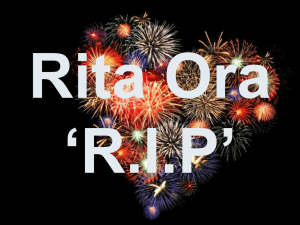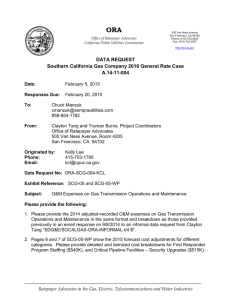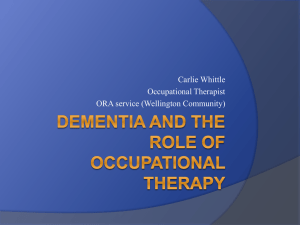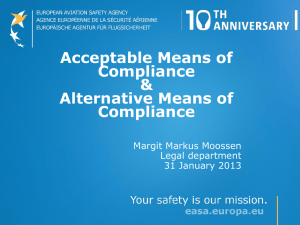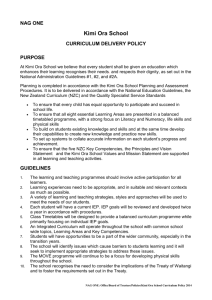AMC 1. ORA. GEN. 200 ( a )( 6 )
advertisement
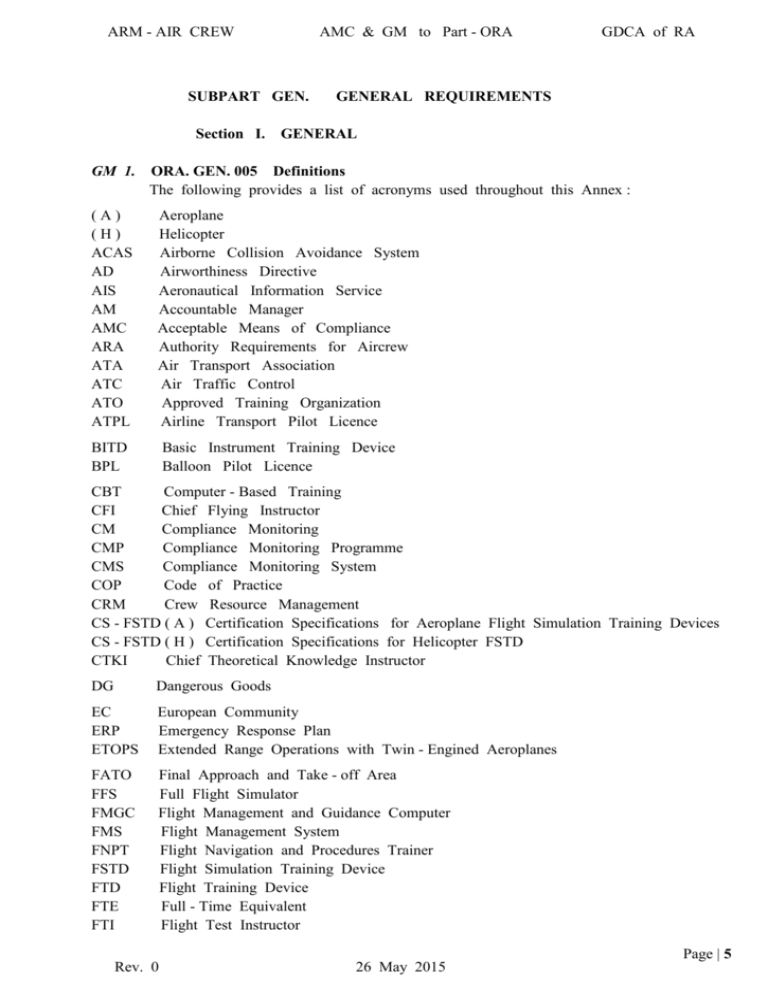
ARM - AIR CREW AMC & GM to Part - ORA SUBPART GEN. Section I. GDCA of RA GENERAL REQUIREMENTS GENERAL GM 1. ORA. GEN. 005 Definitions The following provides a list of acronyms used throughout this Annex : (A) (H) ACAS AD AIS AM AMC ARA ATA ATC ATO ATPL Aeroplane Helicopter Airborne Collision Avoidance System Airworthiness Directive Aeronautical Information Service Accountable Manager Acceptable Means of Compliance Authority Requirements for Aircrew Air Transport Association Air Traffic Control Approved Training Organization Airline Transport Pilot Licence BITD BPL Basic Instrument Training Device Balloon Pilot Licence CBT Computer - Based Training CFI Chief Flying Instructor CM Compliance Monitoring CMP Compliance Monitoring Programme CMS Compliance Monitoring System COP Code of Practice CRM Crew Resource Management CS - FSTD ( A ) Certification Specifications for Aeroplane Flight Simulation Training Devices CS - FSTD ( H ) Certification Specifications for Helicopter FSTD CTKI Chief Theoretical Knowledge Instructor DG Dangerous Goods EC ERP ETOPS European Community Emergency Response Plan Extended Range Operations with Twin - Engined Aeroplanes FATO FFS FMGC FMS FNPT FSTD FTD FTE FTI Final Approach and Take - off Area Full Flight Simulator Flight Management and Guidance Computer Flight Management System Flight Navigation and Procedures Trainer Flight Simulation Training Device Flight Training Device Full - Time Equivalent Flight Test Instructor Page | 5 Rev. 0 26 May 2015 ARM - AIR CREW AMC & GM to Part - ORA GM GMP Guidance Material General Medical Practitioner HEMS HHO HT Helicopter Emergency Medical Service Helicopter Hoist Operation Head of Training IFR IMC IOS IR Instrument Flight Rules Instrument Meteorological Conditions Instructor Operation Station Implementing Rule LAPL LIFUS LVO Light Aircraft Pilot Licence Line Flying Under Supervision Low Visibility Operation MCC MMEL MPA MPL Multi - Crew Cooperation Master Minimum Equipment List Multi - Pilot Aeroplane Multi - Crew Pilot Licence NVIS Night Vision Imaging System OPC ORA OSD OTD Operator Proficiency Check Organization Requirements for Aircrew Operational Suitability Data Other Training Device PBN PF PIC PPL Performance - Based Navigation Pilot Flying Pilot - in - Command Private Pilot Licence QTG Qualification Test Guide SMM SOP SPL Safety Management Manual Standard Operating Procedure Sailplane Pilot Licence TAWS TRE TRI Terrain Awareness Warning System Type Rating Examiner Type Rating Instructor VDR Validation Data Roadmap ZFTT Zero Flight - Time Training GDCA of RA Page | 6 Rev. 0 26 May 2015 ARM - AIR CREW AMC & GM to Part - ORA GDCA of RA AMC 1. ORA. GEN. 120 ( a ) Means of Compliance DEMONSTRATION of COMPLIANCE In order to demonstrate that the Implementing Rules are met, a risk assessment should be completed and documented. The result of this risk assessment should demonstrate that an equivalent level of safety to that established by the Acceptable Means of Compliance ( AMC ) adopted by the EASA is reached. AMC 1. ORA. GEN. 125 Terms of Approval and Privileges of an Organization MANAGEMENT SYSTEM DOCUMENTATION The management system documentation should contain the privileges and detailed scope of activities for which the organization is certified, as relevant to the applicable requirements. The scope of activities defined in the management system documentation should be consistent with the terms of approval. AMC 1. ORA. GEN. 130 Changes to Organizations APPLICATION TIME FRAMES a ) The application for the amendment of an organization certificate should be submitted at least 30 days before the date of the intended changes ; b ) In the case of a planned change of a nominated person, the organization should inform the GDCA at least 10 days before the date of the proposed change ; c ) Unforeseen changes should be notified at the earliest opportunity, in order to enable the GDCA to determine continued compliance with the applicable requirements and to amend, if necessary, the organization certificate and related terms of approval. GM 1. ORA. GEN. 130 ( a ) Changes to Organizations GENERAL a ) Typical examples of changes that may affect the certificate or the terms of approval are listed below : 1 ) the name of the organization ; 2 ) the organization’s principal place of business ; 3 ) the organization’s scope of activities ; 4 ) additional locations of the organization ; 5 ) the accountable manager ; 6 ) any of the persons referred to in ORA. GEN. 210 ( a ) and ( b ) ; 7 ) the organization’s documentation as required by this Part, safety policy and procedures ; 8 ) the facilities. b ) Prior approval by the GDCA is required for any changes to the organization’s procedure describing how changes not requiring prior approval will be managed and notified to the GDCA ; c ) Changes requiring prior approval may only be implemented upon receipt of formal approval by the GDCA. Page | 7 Rev. 0 26 May 2015 ARM - AIR CREW AMC & GM to Part - ORA GDCA of RA GM 2. ORA. GEN. 130 ( a ) Changes to Organizations CHANGE of NAME of the ORGANISATION A change of name requires the organization to submit a new application as a matter of urgency. Where this is the only change to report, the new application can be accompanied by a copy of the documentation previously submitted to the GDCA under the previous name, as a means of demonstrating how the organization complies with the applicable requirements. AMC 1. ORA. GEN. 150 ( b ) Findings GENERAL The corrective action plan defined by the organization should address the effects of the non - conformity, as well as its root - cause. GM 1. ORA. GEN. 150 Findings GENERAL a ) Corrective action is the action to eliminate or mitigate the root cause(s) and prevent recurrence of an existing detected non - compliance or other undesirable condition or situation ; b ) Proper determination of the root cause is crucial for defining effective corrective actions. AMC 1. ORA. GEN. 160 Occurrence Reporting GENERAL a ) The organization should report all occurrences defined in AMC 20 - 8, and as required by the applicable national rules on occurrence reporting in civil aviation ; b ) In addition to the reports required by AMC 20 - 8, the organization should report volcanic ash clouds encountered during flight. Page | 8 Rev. 0 26 May 2015 ARM - AIR CREW Section II. AMC & GM to Part - ORA GDCA of RA Management AMC 1. ORA. GEN. 200 ( a )( 1 ) ; ( 2 ) ; ( 3 ) ; ( 5 ) Management System NON - COMPLEX ORGANISATIONS - GENERAL a ) Safety risk management may be performed using hazard checklists or similar risk management tools or processes, which are integrated into the activities of the organization ; b ) The organization should manage safety risks related to a change. The management of change should be a documented process to identify external and internal change that may have an adverse effect on safety. It should make use of the organization’s existing hazard identification, risk assessment and mitigation processes ; c ) The organization should identify a person who fulfils the role of safety manager and who is responsible for coordinating the safety management system. This person may be the accountable manager or a person with an operational role in the organization ; d ) Within the organization, responsibilities should be identified for hazard identification, risk assessment and mitigation ; e ) The safety policy should include a commitment to improve towards the highest safety standards, comply with all applicable legal requirements, meet all applicable standards, consider best practices and provide appropriate resources ; f ) The organization should, in cooperation with other stakeholders, develop, coordinate and maintain an emergency response plan ( ERP ) that ensures orderly and safe transition from normal to emergency operations and return to normal operations. The ERP should provide the actions to be taken by the organization or specified individuals in an emergency and reflect the size, nature and complexity of the activities performed by the organization. AMC 1. ORA. GEN. 200 ( a )( 1 ) Management System COMPLEX ORGANISATIONS - ORGANISATION and ACCOUNTABILITIES The management system of an organization should encompass safety by including a safety manager and a safety review board in the organizational structure. a ) Safety Manager. 1 ) the safety manager should act as the focal point and be responsible for the development, administration and maintenance of an effective safety management system ; 2 ) the functions of the safety manager should be to : ( i ) facilitate hazard identification, risk analysis and management ; ( ii ) monitor the implementation of actions taken to mitigate risks, as listed in the safety action plan ; ( iii ) provide periodic reports on safety performance ; ( iv ) ensure maintenance of safety management documentation ; ( v ) ensure that there is safety management training available and that it meets acceptable standards ; ( vi ) provide advice on safety matters ; and ( vii ) ensure initiation and follow-up of internal occurrence / accident investigations. b ) Safety Review Board 1 ) the Safety review board should be a high level committee that considers matters of strategic safety in support of the accountable manager’s safety accountability ; 2 ) the board should be chaired by the accountable manager and be composed of heads of functional areas ; Page | 9 Rev. 0 26 May 2015 ARM - AIR CREW AMC & GM to Part - ORA GDCA of RA 3 ) the safety review board should monitor : ( i ) safety performance against the safety policy and objectives ; ( ii ) that any safety action is taken in a timely manner ; and ( iii ) the effectiveness of the organization’s safety management processes. c ) The safety review board should ensure that appropriate resources are allocated to achieve the established safety performance ; d ) The safety manager or any other relevant person may attend, as appropriate, safety review board meetings. He / she may communicate to the accountable manager all information, as necessary, to allow decision making based on safety data. GM 1. ORA. GEN. 200 ( a )( 1 ) Management System SAFETY MANAGER a ) Depending on the size of the organization and the nature and the safety manager may be assisted by additional safety personnel safety management related tasks ; b ) Regardless of the organizational set-up it is important that the unique focal point as regards the development, administration and organization’s safety management system. complexity of its activities, for the performance of all safety manager remains the maintenance of the GM 2. ORA. GEN. 200 ( a )( 1 ) Management System COMPLEX ORGANISATIONS - SAFETY ACTION GROUP a ) A safety action group may be established as a standing group or as an ad-hoc group to assist or act on behalf of the safety review board ; b ) More than one safety action group may be established depending on the scope of the task and specific expertise required ; c ) The safety action group should report to and take strategic direction from the safety review board and should be comprised of managers, supervisors and personnel from operational areas ; d ) The safety action group should : that safety 1 ) monitor operational safety ; 2 ) resolve identified risks ; 3 ) assess the impact on safety of operational changes ; and 4 ) ensure actions are implemented within agreed timescales. e ) The safety action group should review the effectiveness of previous safety recommendations and safety promotion. COMPLEX ORGANISATIONS - SAFETY POLICY a ) The safety policy should : 1 ) be endorsed by the accountable manager ; 2 ) reflect organizational commitments regarding safety and its proactive and systematic management ; 3 ) be communicated, with visible endorsement, throughout the organization ; and 4 ) include safety reporting principles. b ) The safety policy should include a commitment : 1 ) to improve towards the highest safety standards ; 2 ) to comply with all applicable legislation, meet all applicable standards and consider best practices ; Page | 10 Rev. 0 26 May 2015 ARM - AIR CREW AMC & GM to Part - ORA GDCA of RA 3 ) to provide appropriate resources ; 4 ) to enforce safety as one primary responsibility of all managers ; and 5 ) not to blame someone for reporting something which would not have been otherwise detected. c ) Senior management should : 1 ) continually promote the safety policy to all personnel and demonstrate their commitment to it ; 2 ) provide necessary human and financial resources for its implementation ; and 3 ) establish safety objectives and performance standards. GM 1. ORA. GEN. 200 ( a )( 2 ) Management System SAFETY POLICY The safety policy is the means whereby the organization states its intention to maintain and, where practicable, improve safety levels in all its activities and to minimize its contribution to the risk of an aircraft accident as far as is reasonably practicable. The safety policy should state that the purpose of safety reporting and internal investigations is to improve safety, not to apportion blame to individuals. AMC 1. ORA. GEN. 200 ( a )( 3 ) Management System COMPLEX ORGANIZATIONS - SAFETY RISK MANAGEMENT a ) Hazard identification processes. 1 ) reactive and proactive schemes for hazard identification should be the formal means of collecting, recording, analyzing, acting on and generating feedback about hazards and the associated risks that affect the safety of the operational activities of the organization ; 2 ) all reporting systems, including confidential reporting schemes, should include an effective feedback process. b ) Risk assessment and mitigation processes. 1 ) a formal risk management process should be developed and maintained that ensures analysis ( in terms of likelihood and severity of occurrence ), assessment ( in terms of tolerability ) and control ( in terms of mitigation ) of risks to an acceptable level. 2 ) the levels of management who have the authority to make decisions regarding the tolerability of safety risks, in accordance with ( b )( 1 ), should be specified. c ) Internal safety investigation. 1 ) the scope of internal safety investigations should extend beyond the scope of occurrences required to be reported to the GDCA. d ) Safety performance monitoring and measurement. 1 ) safety performance monitoring and measurement should be the process by which the safety performance of the organization is verified in comparison to the safety policy and objectives. 2 ) this process should include : ( i ) safety reporting ; ( ii ) safety studies, that is, rather large analyses encompassing broad safety concerns ; ( iii ) safety reviews including trends reviews, which would be conducted during introduction and deployment of new technologies, change or implementation of procedures, or in situations of structural change in operations ; Page | 11 Rev. 0 26 May 2015 ARM - AIR CREW AMC & GM to Part - ORA GDCA of RA ( iv ) safety audits focusing on the integrity of the organization’s management system, and periodically assessing the status of safety risk controls ; and ( v ) safety surveys, examining particular elements or procedures of a specific operation, such as problem areas or bottlenecks in daily operations, perceptions and opinions of operational personnel and areas of dissent or confusion. e ) The management of change. The organization should manage safety risks related to a change. The management of change should be a documented process to identify external and internal change that may have an adverse effect on safety. It should make use of the organization’s existing hazard identification, risk assessment and mitigation processes ; f ) Continuous improvement. The organization should continuously seek to improve its safety performance. Continuous improvement should be achieved through : 1 ) proactive and reactive evaluations of facilities, equipment, documentation and procedures through safety audits and surveys ; 2 ) proactive evaluation of individuals’ performance to verify the fulfillment of their safety responsibilities ; and 3 ) reactive evaluations in order to verify the effectiveness of the system for control and mitigation of risk. g ) The Emergency Response Plan ( ERP ). 1 ) an ERP should be established that provides the actions to be taken by the organization or specified individuals in an emergency. The ERP should reflect the size, nature and complexity of the activities performed by the organization ; 2 ) the ERP should ensure : ( i ) an orderly and safe transition from normal to emergency operations ; ( ii ) safe continuation of operations or return to normal operations as soon as practicable ; ( iii ) coordination with the emergency response plans of other organizations, where appropriate. GM 1. ORA. GEN. 200 ( a )( 3 ) Management System INTERNAL OCCURRENCE REPORTING SCHEME a ) The overall purpose of the scheme is to use reported information to improve the level of safety performance of the organization and not to attribute blame ; b ) The objectives of the scheme are to : 1 ) enable an assessment to be made of the safety implications of each relevant incident and accident, including previous similar occurrences, so that any necessary action can be initiated ; 2 ) ensure that knowledge of relevant incidents and accidents is disseminated, so that other persons and organizations may learn from them. c ) The scheme is an essential part of the overall monitoring function and it is complementary to the normal day-to-day procedures and “ control “ systems and is not intended to duplicate or supersede any of them. The scheme is a tool to identify those instances where routine procedures have failed ; Page | 12 Rev. 0 26 May 2015 ARM - AIR CREW AMC & GM to Part - ORA GDCA of RA d ) All occurrence reports judged reportable by the person submitting the report should be retained as the significance of such reports may only become obvious at a later date. AMC 1. ORA. GEN. 200 ( a )( 4 ) Management System TRAINING and COMMUNICATION on SAFETY a ) Training. 1 ) all personnel should receive safety training as appropriate for their safety responsibilities ; 2 ) adequate records of all safety training provided should be kept. b ) Communication. 1 ) the organization should establish communication about safety matters that : ( i ) ensures that all personnel are aware of the safety management activities as appropriate for their safety responsibilities ; ( ii ) conveys safety critical information, especially relating to assessed risks and analyzed hazards ; ( iii ) explains why particular actions are taken ; and ( iv ) explains why safety procedures are introduced or changed. 2 ) regular meetings with personnel where information, actions and procedures are discussed may be used to communicate safety matters. GM 1. ORA. GEN. 200 ( a )( 4 ) Management System TRAINING and COMMUNICATION on SAFETY The safety training programme may consist of self-instruction via a media ( newsletters, flight safety magazines ), class-room training, e-learning or similar training provided by training service providers. AMC 1. ORA. GEN. 200 ( a )( 5 ) Management System ORGANISATION’S MANAGEMENT SYSTEM DOCUMENTATION a ) The organization’s management system documentation should at least include the following information : 1 ) a statement signed by the accountable manager to confirm that the organization will continuously work in accordance with the applicable requirements and the organization’s documentation as required by this Part ; 2 ) the organization's scope of activities ; 3 ) the titles and names of persons referred to in ORA.GEN.210 ( a ) and ( b ) ; 4 ) an organization chart showing the lines of responsibility between the persons referred to in ORA.GEN.210 ; 5 ) a general description and location of the facilities referred to in ORA.GEN.215 ; 6 ) procedures specifying how the organization ensures compliance with the applicable requirements ; 7 ) the amendment procedure for the organization’s management system documentation. b ) The organization’s management system documentation may be included in a separate manual or in ( one of ) the manual(s) as required by the applicable Subpart(s). A cross reference should be included. Page | 13 Rev. 0 26 May 2015 ARM - AIR CREW AMC & GM to Part - ORA GDCA of RA GM 1. ORA. GEN. 200 ( a )( 5 ) Management System ORGANISATION’S MANAGEMENT SYSTEM DOCUMENTATION a ) It is not required to duplicate information in several manuals. The information may be contained in any of the organization manuals ( e. g. operations manual, training manual ), which may also be combined ; b ) The organization may also choose to document some of the information required to be documented in separate documents ( e. g. procedures ). In this case, it should ensure that manuals contain adequate references to any document kept separately. Any such documents are then to be considered an integral part of the organization’s management system documentation. AMC 1. ORA. GEN. 200 ( a )( 5 ) Management System COMPLEX ORGANIZATIONS – ORGANIZATION’S SAFETY MANAGEMENT MANUAL a ) The Safety Management Manual ( SMM ) should be the key instrument for communicating the approach to safety for the whole of the organization. The SMM should document all aspects of safety management, including the safety policy, objectives, procedures and individual safety responsibilities ; b ) The contents of the Safety Management Manual should include all of the following : 1 ) scope of the Safety Management System ; 2 ) safety policy and objectives ; 3 ) safety accountability of the accountable manager ; 4 ) safety responsibilities of key safety personnel ; 5 ) documentation control procedures ; 6 ) hazard identification and risk management schemes ; 7 ) safety action planning ; 8 ) safety performance monitoring ; 9 ) incident investigation and reporting ; 10 ) emergency response planning ; 11 ) management of change ( including organizational changes with regard to safety responsibilities ) ; 12 ) safety promotion. c ) The SMM may be contained in ( one of ) the manual(s) of the organization. AMC 1. ORA. GEN. 200 ( a )( 6 ) Management System COMPLIANCE MONITORING - GENERAL a ) Compliance monitoring. The implementation and use of a compliance monitoring function should enable the organization to monitor compliance with the relevant requirements of this Part and other applicable Parts ; 1 ) the organization should specify the basic structure of the compliance monitoring function applicable to the activities conducted ; 2 ) the compliance monitoring function should be structured according to the size of the organization and the complexity of the activities to be monitored. b ) Organizations should monitor compliance with the procedures they have designed to ensure safe activities. In doing so, they should as a minimum, and where appropriate, monitor : 1 ) privileges of the organization ; 2 ) manuals, logs, and records ; Page | 14 Rev. 0 26 May 2015 ARM - AIR CREW AMC & GM to Part - ORA GDCA of RA 3 ) training standards ; 4 ) management system procedures and manuals. c ) Organizational set up. 1 ) to ensure that the organization continues to meet the requirements of this Part and other applicable Parts, the accountable manager should designate a compliance monitoring manager. The role of the compliance monitoring manager is to ensure that the activities of the organization are monitored for compliance with the applicable regulatory requirements , and any additional requirements as established by the organization, and that these activities are being carried out properly under the supervision of the relevant head of functional area ; 2 ) the compliance monitoring manager should be responsible for ensuring that the compliance monitoring programme is properly implemented, maintained and continually reviewed and improved ; 3 ) the compliance monitoring manager should : ( i ) have direct access to the accountable manager ; ( ii ) not be one of the other persons referred to in ORA. GEN. 210 ( b ) ; ( iii ) be able to demonstrate relevant knowledge, background and appropriate experience related to the activities of the organization ; including knowledge and experience in compliance monitoring ; and ( iv ) have access to all parts of the organization, and as necessary, any contracted organization. 4 ) in the case of a non-complex organization, this task may be exercised by the accountable manager provided he / she has demonstrated having the related competence as defined in ( c ) ( 3 )( iii ) ; 5 ) in the case the same person acts as compliance monitoring manager and as safety manager, the accountable manager, with regards to his / her direct accountability for safety, should ensure that sufficient resources are allocated to both functions, taking into account the size of the organization and the nature and complexity of its activities ; 6 ) the independence of the compliance monitoring function should be established by ensuring that audits and inspections are carried out by personnel not responsible for the function, procedure or products being audited. d ) Compliance monitoring documentation. 1 ) relevant documentation should include the relevant part(s) of the organization’s management system documentation ; 2 ) in addition, relevant documentation should also include the following : ( i ) terminology ; ( ii ) specified activity standards ; ( iii ) a description of the organization ; ( iv ) the allocation of duties and responsibilities ; ( v ) procedures to ensure regulatory compliance ; ( vi ) the compliance monitoring programme, reflecting : (A) schedule of the monitoring programme ; (B) audit procedures ; (C) reporting procedures ; (D) follow-up and corrective action procedures ; and (E) recording system. Page | 15 Rev. 0 26 May 2015 ARM - AIR CREW e) 1) 2) 3) 4) AMC & GM to Part - ORA GDCA of RA ( vii ) the training syllabus referred to in ( e )( 2 ) ; ( viii ) document control. Training. correct and thorough training is essential to optimize compliance in every organization. In order to achieve significant outcomes of such training, the organization should ensure that all personnel understand the objectives as laid down in the organization’s management system documentation ; those responsible for managing the compliance monitoring function should receive training on this task. Such training should cover the requirements of compliance monitoring, manuals and procedures related to the task, audit techniques, reporting and recording ; time should be provided to train all personnel involved in compliance management and for briefing the remainder of the personnel ; the allocation of time and resources should be governed by the volume and complexity of the activities concerned. GM 1. ORA. GEN. 200 ( a )( 6 ) Management System COMPLIANCE MONITORING - GENERAL a ) The organizational set-up of the compliance monitoring function should reflect the size of the organization and the nature and complexity of its activities. The compliance monitoring manager may perform all audits and inspections himself / herself or appoint one or more auditors by choosing personnel having the related competence as defined in AMC 1. ORA. GEN. 200 ( a )( 6 ) point ( c )( 3 )( iii ), either from within or outside the organization ; b ) Regardless of the option chosen it must be ensured that the independence of the audit function is not affected, in particular in cases where those performing the audit or inspection are also responsible for other functions within the organization ; c ) In case external personnel are used to perform compliance audits or inspections : 1 ) any such audits or inspections are performed under the responsibility of the compliance monitoring manager ; and 2 ) the organization remains responsible to ensure that the external personnel has relevant knowledge, background and experience as appropriate to the activities being audited or inspected ; including knowledge and experience in compliance monitoring ; d ) The organization retains the ultimate responsibility for the effectiveness of the compliance monitoring function in particular for the effective implementation and follow-up of all corrective actions. GM 2. ORA. GEN. 200 ( a )( 6 ) Management System COMPLEX ORGANISATIONS - COMPLIANCE MONITORING PROGRAMME for ATOs a ) Typical subject areas for compliance monitoring audits and inspections for Approved Training Organizations ( ATOs ) should be the following : 1 ) facilities ; 2 ) actual flight and ground training ; 3 ) technical standards. b ) ATOs should monitor compliance with the training and operations manuals they have designed to ensure safe and efficient training. In doing so, they should, where appropriate, additionally monitor the following : Page | 16 Rev. 0 26 May 2015 ARM - AIR CREW 1) 2) 3) 4) AMC & GM to Part - ORA GDCA of RA training procedures ; flight safety ; flight and duty time limitations, rest requirements and scheduling ; aircraft maintenance / operations interface. GM 3. ORA. GEN. 200 ( a )( 6 ) Management System AUDIT and INSPECTION a ) “ Audit “ means a systematic, independent and documented process for obtaining evidence and evaluating it objectively to determine the extent to which requirements are complied with ; b ) “ Inspection “ means an independent documented conformity evaluation by observation and judgment accompanied as appropriate by measurement, testing or gauging, in order to verify compliance with applicable requirements. AMC 1. ORA. GEN. 200 ( b ) Management System SIZE, NATURE and COMPLEXITY of the ACTIVITY a ) An organization should be considered as complex when it has a workforce of more than 20 Full Time Equivalents ( FTEs ) involved in the activity subject to CR-EC No 216 / 2008 and its Implementing Rules ; b ) Organizations with up to 20 Full Time Equivalents ( FTEs ) involved in the activity subject to CR-EC No 216 / 2008 and its Implementing Rules, may also be considered complex based on an assessment of the following factors : 1 ) in terms of complexity, the extent and scope of contracted activities subject to the approval ; 2 ) in terms of risk criteria, whether any of the following are present : ( i ) operations requiring the following specific approvals : Performance - Based Navigation ( PBN ) ; Low Visibility Operation ( LVO ) ; Extended Range Operations with Two - Engined Aeroplanes ( ETOPS ) ; Helicopter Hoist Operation ( HHO ) ; Helicopter Emergency Medical Service ( HEMS ) ; Night Vision Imaging System ( NVIS ) and Dangerous Goods ( DG ) ; ( ii ) different types of aircraft used ; ( iii ) the environment ( offshore, mountainous area etc.. ). c ) Regardless of the criteria mentioned in ( a ) and ( b ), the following organizations should always be considered as non-complex : 1 ) Approved Training Organizations ( ATOs ) only providing training for the Light Aircraft Pilot Licence ( LAPL ), Private Pilot Licence ( PPL ), Sailplane Pilot Licence ( SPL ) or Balloon Pilot Licence ( BPL ) and the associated Ratings and Certificates ; 2 ) Aero - Medical Centres ( AeMCs ). Page | 17 Rev. 0 26 May 2015 ARM - AIR CREW AMC & GM to Part - ORA GDCA of RA AMC 1. ORA. GEN. 205 Contracted Activities RESPONSIBILITY when CONTRACTING ACTIVITIES a ) The organization may decide to contract certain activities to external organizations ; b ) A written agreement should exist between the organization and the contracted organization clearly defining the contracted activities and the applicable requirements ; c ) The contracted safety related activities relevant to the agreement should be included in the organization's safety management and compliance monitoring programmes ; d ) The organization should ensure that the contracted organization has the necessary authorization or approval when required, and commands the resources and competence to undertake the task. GM 1. ORA. GEN. 205 Contracted Activities RESPONSIBILITY when CONTRACTING ACTIVITIES a ) Regardless of the approval status of the contracted organization, the contracting organization is responsible to ensure that all contracted activities are subject to hazard identification and risk management as required by ORA.GEN.200 ( a )( 3 ) and to compliance monitoring as required by ORA.GEN.200 ( a )( 6 ) ; b ) When the contracted organization is itself certified to carry out the contracted activities, the organization’s compliance monitoring should at least check that the approval effectively covers the contracted activities and that it is still valid ; c ) If the organization requires the contracted organization to conduct an activity which exceeds the contracted organization’s terms of approval, this will be considered as the contracted organization working under the approval of the contracting organization. AMC 1. ORA. GEN. 215 Facility Requirements ATOs PROVIDING TRAINING for the CPL, MPL AND ATPL and the ASSOCIATED RATINGS and CERTIFICATES a ) For ATOs providing flight training, the following flight operations accommodation should be available : 1 ) an operations room with facilities to control flying operations ; 2 ) a flight planning room with the following facilities : ( i ) appropriate current maps and charts ; ( ii ) current Aeronautical Information Service ( AIS ) information ; ( iii ) current meteorological information ; ( iv ) communications to Air Traffic Control ( ATC ) and the operations room ; ( v ) any other flight safety related material. 3 ) adequate briefing rooms / cubicles of sufficient size and number ; 4 ) suitable offices for the supervisory personnel and room(s) to allow flight instructors to write reports on students, complete records and other related documentation ; 5 ) furnished crew-room(s) for instructors and students. b ) For ATOs providing theoretical knowledge training, the following facilities for theoretical knowledge instruction should be available : 1 ) adequate classroom accommodation for the current student population ; 2 ) suitable demonstration equipment to support the theoretical knowledge instruction ; 3 ) a radiotelephony training and testing facility ; Page | 18 Rev. 0 26 May 2015 ARM - AIR CREW AMC & GM to Part - ORA GDCA of RA 4 ) a reference library containing publications giving coverage of the syllabus ; 5 ) offices for the instructional personnel. AMC 2. a) 1) 2) 3) 4) 5) b) c) ORA. GEN. 215 Facility Requirements ATOs PROVIDING TRAINING for the LAPL, PPL, SPL OR BPL and the ASSOCIATED RATINGS and CERTIFICATES The following flight operations accommodation should be available : a flight planning room with the following facilities : ( i ) appropriate current aviation maps and charts ; ( ii ) current AIS information ; ( iii ) current meteorological information ; ( iv ) communications to ATC ( if applicable ) ; ( v ) any other flight safety related material. adequate briefing room(s) / cubicles of sufficient size and number ; suitable office(s) to allow flight instructors to write reports on students, complete records and other related documentation ; suitable rest areas for instructors and students, where appropriate to the training task ; in the case of ATOs providing training for the BPL or LAPL ( B ) only, the flight operations accommodation listed in ( a )( 1 ) to ( a )( 4 ) may be replaced by other suitable facilities when operating outside aerodromes. The following facilities for theoretical knowledge instruction should be available : 1 ) adequate classroom accommodation for the current student population ; 2 ) suitable demonstration equipment to support the theoretical knowledge instruction ; 3 ) suitable office(s) for the instructional personnel. A single room may be sufficient to provide the functions listed in ( a ) and ( b ). AMC 1. ORA. GEN. 220 ( b ) Record - keeping GENERAL a ) The record-keeping system should ensure that all records are accessible whenever needed within a reasonable time. These records should be organized in a way that ensures traceability and retrievability throughout the required retention period ; b ) Records should be kept in paper form or in electronic format or a combination of both. Records stored on microfilm or optical disc format are also acceptable. The records should remain legible throughout the required retention period. The retention period starts when the record has been created or last amended ; c ) Paper systems should use robust material which can withstand normal handling and filing. Computer systems should have at least one backup system which should be updated within 24 hours of any new entry. Computer systems should include safeguards against the ability of unauthorized personnel to alter the data ; d ) All computer hardware used to ensure data backup should be stored in a different location from that containing the working data and in an environment that ensures they remain in good condition. When hardware or software changes take place, special care should be taken that all necessary data continues to be accessible at least through the full period specified in the relevant Subpart. In the absence of such indication, all records should be kept for a minimum period of 5 years. Page | 19 Rev. 0 26 May 2015 ARM - AIR CREW AMC & GM to Part - ORA GDCA of RA GM 1. ORA. GEN. 220 ( b ) Record - keeping RECORDS Microfilming or optical storage of records may be carried out at any time. The records should be as legible as the original record and remain so for the required retention period. Page | 20 Rev. 0 26 May 2015
